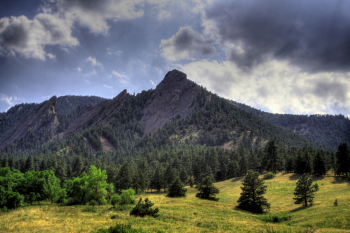CSDMS Community portal
CSDMS Community
About CSDMS | ||||||||||||
|---|---|---|---|---|---|---|---|---|---|---|---|---|
 | ||||||||||||
History
The CSDMS Project is an NSF-funded, international effort to develop a suite of modular numerical models able to simulate the evolution of landscapes and sedimentary basins, on time scales ranging from individual events to many millions of years. CSDMS is an acronym for Community Surface Dynamics Modeling System. Ideas behind the CSDMS concept were discussed by participants of an international workshop, Numerical Experiments in Stratigraphy (University of Kansas, May 15-17, 1996), with formal presentation of these findings at the third annual conference of the International Association of Mathematical Geology (Barcelona, 1997: Syvitski, et al, 1997). The formal CSDMS idea, however, took shape at a panel convened by the Geology/Paleontology Program of NSF in March 1999. That panel identified a CSDMS as a high priority NSF research initiative in sedimentary geology, and since then the concept has been widely discussed in the North American sediment-dynamics community. The history behind CSDMS began in the mid-1960s, with a very interesting article (Bonham-Carter and Sutherland, 1967; also see Harbaugh and Bonham-Carter, 1970). Graeme Bonham-Carter coded up sediment transport equations related to a river's discharge into the ocean, to provide us with new insights into the formation of sedimentary deposits. The exercise was completed at a time when application of the Navier-Stokes equation to sediment transport remained in its infancy, and when we fed computer cards into memory-poor, slow-speed mainframes. Ten years later saw the first volume describing the full spectrum of numerical models related to ocean dynamics (Goldberg et al, 1977). The emphasis of these articles was on getting the dynamics correct and this resulted in some papers (e.g. Smith, 1977; Komar, 1977) being conceptually ahead of available field tools and data. Through the next decade, as computers advanced with our ability to develop code, the softrock community applied its maturing understanding of hydraulics and sediment transport to the formation and modification of sedimentary deposits. In 1988, a large representation of this community met in the mountains of Colorado, and the concept of quantitative dynamic stratigraphy (QDS) was born (Cross, 1989). At the meeting, a mechanistic view of QDS was contrasted with the more rapidly maturing rule-based (sometimes known as geometric-based) stratigraphic models (see Syvitski, 1989, for discussion). The need to understand local to regional boundary conditions, either over long periods of simulated time, or for conditions where we have little field data (i.e. extreme event modeling) went on to change the way sedimentologists conducted their field and numerical experiments. Through the next decade, the QDS community and discipline grew and influenced the field of both sedimentology and stratigraphy (Agterberg and Bonham-Carter, 1989; Martinez and Harbaugh, 1993; Franseen et al., 1991; Harff et al., 1998; Harbaugh et al., 1999; Paola, 2000; Syvitski and Bahr, 2001, Syvitski et al.,, 2007). Now we approach a time when these marvelous individual efforts can be multiplied in their effectiveness if better coordinated, and openness is developed between the modelers and field-oriented geoscientists. The earth system surface dynamic models, like the established Community Climate System Model or the Regional Ocean Modeling System, are based on algorithms that mathematically describe the processes and conditions relevant to water, sediment and solute transport, and would incorporate all the important input and boundary conditions that define an environmental system. The CSDMS effort is coordinated and funded by government agencies and industry, to support the development of optimum algorithms, input parameters, feedback loops, and observations at the relevant scales necessary, to better provide an understanding of earth-surface systems. The Community Surface Dynamics Modeling System is being designed to address issues, for example, when the earth was abiotic, hotter or colder, when there was no flocculation, when the moon was closer, or the oceans were more saline. CSDMS provides modeling support to those working on modern environmental applications, future global warming scenarios, natural disaster mitigation efforts, natural hazard efforts, reservoir characterization, oil exploration, and national security. New satellite and geophysical databases will only realize their full potential in collaboration with efforts like the Community Surface Dynamics Modeling System. Documents
CSDMS Reports
Contact us
CSDMS Contact Information
More about directions to the CSDMS Integration Facility
CSDMS would like to acknowledge INSTAAR, the Institute for Arctic and Alpine Research, for providing the physical space for the CSDMS Integration Facility. Local Links: |
Join |
|---|
 Join a CSDMS Working Group and or Focus Research Group. Membership is open to all interested participants. Each member agrees to participate in working group discussions, review activities, group projects, and, whenever possible, working group meetings. Or watch this movie of how to join. |
Contribute |
|---|
 CSDMS is a community project, so we need your input! There are many levels to contribute to CSDMS. Read more on how you can help making CSDMS a success... |
CSDMS groups |
|---|
CSDMS currently has a total of 8 groups, which includes 5 Working Groups, and 3 Focus Research Groups. The groups meet once per year, coordinating much of their ongoing activities through email and associated to some of the important disciplinary meetings (for example AGU). Read more... |
Industry partners |
|---|
Industrial partners have shown interest, collaborate with and support CSDMS efforts on various levels. Find out which industrial partners support CSDMS ... |
Government partners |
|---|
Numerious government agencies are supporting CSDMS in various ways. Major funding for CSDMS comes from a cooperative agreement with the National Science Foundation. Read more which agencies are supporting CSDMS... |
Organization |
|---|
Contact us |
|---|







